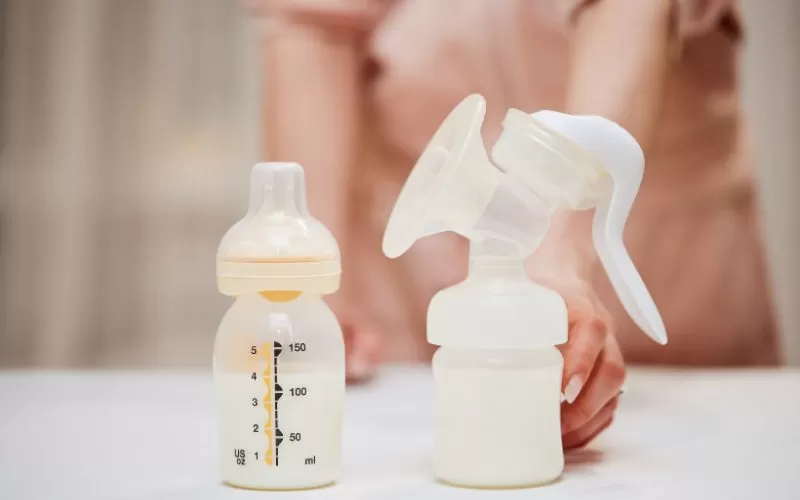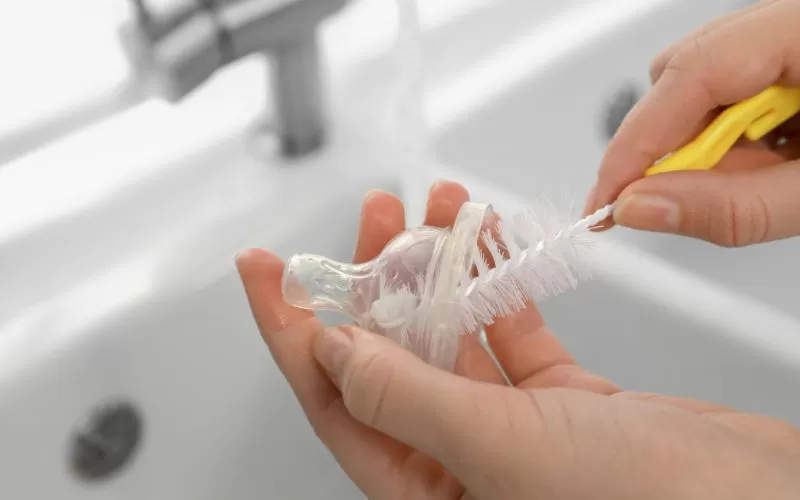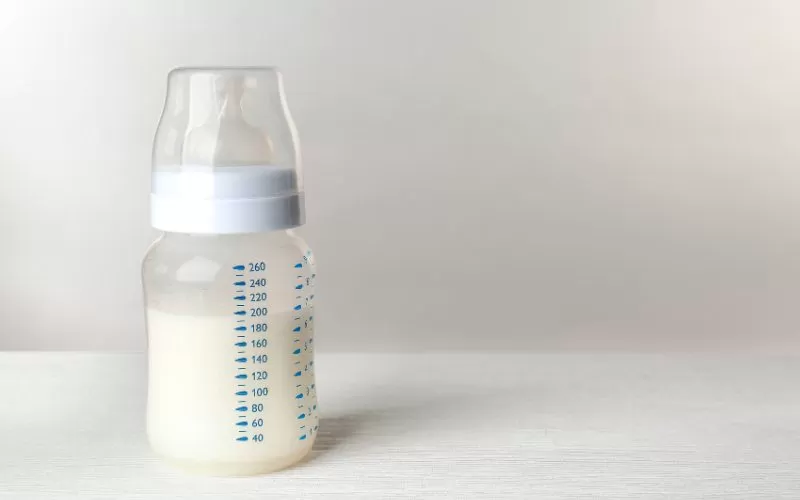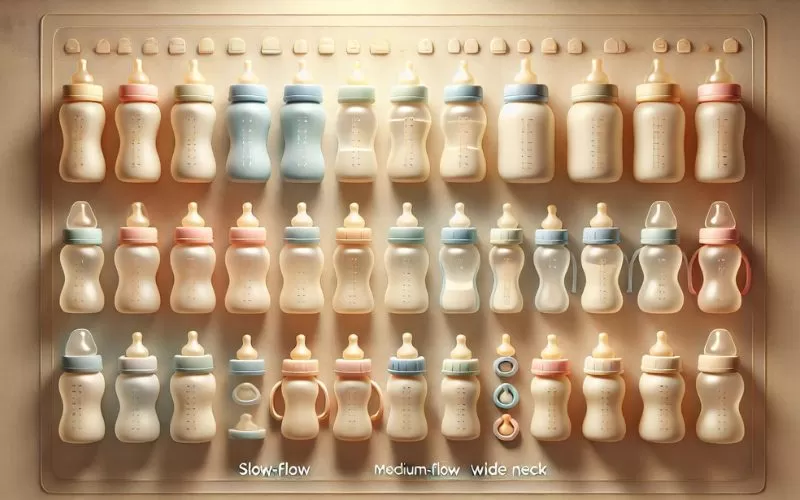Table of Contents
Right Baby Bottles Nipples
When it comes to feeding your baby, choosing the right bottles and nipples is essential for their comfort and proper nutrition. Bottle-feeding is not a one-size-fits-all situation, and with so many options available, it can be overwhelming to make the right choice. In this comprehensive guide, we will walk you through everything you need to know about selecting the perfect bottles and nipples for your baby. Along the way, we’ll also introduce some top products from our store that can make bottle-feeding easier and more enjoyable for both you and your little one.
When it comes to selecting the right bottles and nipples, it’s essential to understand the different types available and their benefits. For a comprehensive guide on bottle feeding techniques and recommendations, including the use of slow-flow nipples and paced feeding methods, visit UC Davis Health’s Infant Driven Feeding Guide.
Understanding the Basics of Bottle-Feeding

Bottle-feeding is often chosen by parents for various reasons, whether it’s to supplement breastfeeding, provide formula, or for convenience. The right bottle and nipple can make a big difference in your baby’s feeding experience, helping to reduce colic, ensure proper latching, and regulate the flow of milk.
When starting out, it’s important to understand that babies have different preferences, and you might need to try a few options before finding the best fit. Luckily, our store offers a wide range of bottles, such as the Feeding Bottle, designed to prevent gas and discomfort.
As you embark on your bottle-feeding journey, it’s essential to consider the transition to solid foods when your baby is ready. To help you navigate this new phase with ease, check out our comprehensive guide, Introducing Solids Without the Stress: A Guide for Parents. This article provides valuable insights and tips to ensure a smooth introduction to solids, making mealtimes enjoyable for both you and your baby. From understanding your baby’s readiness for solids to exploring nutritious options, our guide is designed to empower you every step of the way.
How to Choose the Right Bottle Nipple Size and Flow Level

One of the most crucial aspects of bottle-feeding is selecting the appropriate nipple size and flow level. Newborns generally require a slow flow to prevent choking or overfeeding, while older babies may need a faster flow as they grow. To determine the right size, always look at your baby’s age and feeding habits.
Our Adjustable Flow Bottle Nipples are a great solution because they allow you to adjust the flow based on your baby’s needs, making it a versatile option for growing infants. As your baby becomes more experienced with feeding, you can easily switch to a faster flow nipple without needing to buy a whole new set of bottles.
Key Factors to Consider When Choosing Nipples:
- Age: Nipples are generally labeled by age groups (0-3 months, 3-6 months, etc.). Always start with a slow flow for newborns.
- Flow Rate: If your baby seems frustrated or is taking too long to finish a bottle, it may be time to switch to a higher flow nipple.
- Material: Silicone and latex are the two most common materials used for nipples. Silicone nipples, like those in our Premium Feeding Set, are durable and resist odor, making them a great choice for regular use.
Ultimate Guide: Which Feeding Bottle Is Best for Your Baby?

When deciding on the right feeding bottle for your baby, it’s essential to consider factors such as the material, shape, and ease of cleaning. There are three main types of feeding bottles: plastic, glass, and stainless steel. Each type has its benefits and drawbacks, and understanding these will help you make an informed decision.
- Plastic Bottles: These are lightweight, shatterproof, and affordable. Most modern plastic bottles are BPA-free, like our BPA-Free Plastic Bottles, ensuring that your baby stays safe from harmful chemicals. However, they may need to be replaced more frequently due to wear and tear.
- Glass Bottles: Glass is a more eco-friendly and durable option, though they are heavier and can break easily. Many parents love the longevity and purity of glass bottles, knowing there’s no risk of chemical leaching.
- Stainless Steel Bottles: These are the most durable and long-lasting but can be more expensive. They also retain temperature well, making them great for storing milk at the right temperature.
Different Types of Feeding Bottles for Newborns

Newborns have specific feeding needs, and finding the right bottle can significantly affect their comfort and digestion. There are several specialized bottles designed to address common issues such as colic, spit-up, and gas. Knowing the different types can help you choose the best one for your baby.
- Anti-Colic Bottles: These bottles have a venting system that helps reduce the amount of air your baby ingests during feeding, thus reducing gas and discomfort. If your baby often suffers from colic, consider the Anti-Colic Venting Bottle, which is designed specifically to minimize this problem.
- Wide-Neck Bottles: If you’re transitioning between breastfeeding and bottle-feeding, wide-neck bottles can make the transition easier as they more closely resemble the shape of a breast. Our Wide-Neck Silicone Bottles are soft and flexible, offering a comfortable experience for both the baby and the parent.
- Disposable Liner Bottles: These bottles use a disposable liner that collapses as your baby drinks, reducing air intake. This is a convenient option for on-the-go parents, as you don’t have to clean the bottle as often.
Selecting the right bottle for your newborn may take some trial and error, but with the right information and options, you’ll find a solution that works best for your baby’s needs.
Transitioning from breastfeeding to bottle-feeding can be a significant change for both you and your baby. It’s essential to approach this process with care and patience to ensure a smooth transition. For valuable insights and practical tips on making this shift easier, be sure to check out our article on Breast to Bottle: Tips for Transitioning to Bottle Feeding. You’ll find helpful strategies to help your baby adapt to the bottle while maintaining a positive feeding experience.
How to Choose the Right Bottle Nipple Size and Flow Level Recap
By now, you understand how crucial it is to choose the correct nipple size and flow level for your baby. Ensuring that the nipple matches your baby’s age and feeding ability can help prevent feeding issues, such as choking or gas. Remember, how to choose the right bottle nipple size and flow level depends on observing your baby’s feeding cues and adjusting accordingly.
If your baby seems to finish their bottle too quickly or struggles with the current flow, it’s time to consider switching to a faster flow. On the other hand, if they are dribbling milk or coughing during feeds, you might need to move to a slower flow. Our Adjustable Flow Nipples offer a convenient way to adapt to your baby’s changing needs.
Cleaning and Maintenance Tips for Bottles and Nipples

To ensure your baby’s feeding equipment stays safe and hygienic, it’s essential to clean bottles and nipples thoroughly after every use. Regular sterilization helps prevent the growth of harmful bacteria. Here are some useful tips:
- Handwashing vs. Dishwasher: While many bottles and nipples are dishwasher-safe, it’s still best to hand wash them with a bottle brush to ensure thorough cleaning.
- Sterilize regularly: Especially for newborns, it’s a good idea to sterilize bottles and nipples by boiling them in water or using a sterilizer after each use.
- Replace worn-out parts: Over time, nipples can break down and lose their shape. Be sure to replace them as soon as you notice wear or after about 3 months of regular use.
At our store, we offer Sterilizing Kits to ensure your baby’s feeding equipment stays as clean and safe as possible.
Ultimate Guide: Which Feeding Bottle Is Best for Your Baby? Recap

In summary, when deciding which bottle is best for your baby, consider the material, shape, and any special features that might address your baby’s needs. Whether you choose plastic, glass, or stainless steel, each option has its own advantages. The ultimate guide: which feeding bottle is best for your baby boils down to what works best for your family’s lifestyle and preferences. We recommend trying a few different types to see which your baby prefers and sticking with the one that makes feeding time the easiest for both of you.
For parents considering both bottle-feeding and breastfeeding, understanding the fundamentals of breastfeeding is essential. Our Breastfeeding Guide: How to Get Off to a Great Start offers valuable insights into establishing a successful breastfeeding routine. It covers everything from proper latching techniques to tips for maintaining milk supply, ensuring that your baby receives the best nutrition possible. Whether you choose to exclusively breastfeed, bottle-feed, or do a combination of both, having a solid foundation in breastfeeding can greatly enhance your feeding experience.
Conclusion
Choosing the right bottles and nipples for your baby can be a daunting task, but with the right information, it becomes much easier. Consider your baby’s needs, their age, and any feeding issues they may have when selecting bottles and nipples. Whether you’re looking for different types of feeding bottles for newborns or wondering how to choose the right bottle nipple size and flow level, our store offers a range of products that cater to every parent’s needs.
By investing in high-quality feeding products such as the Anti-Colic Feeding Bottle, Adjustable Flow Nipples, and Sterilizing Kits, you can ensure a smooth, comfortable feeding experience for your little one. Visit our store today to explore more baby care essentials!

